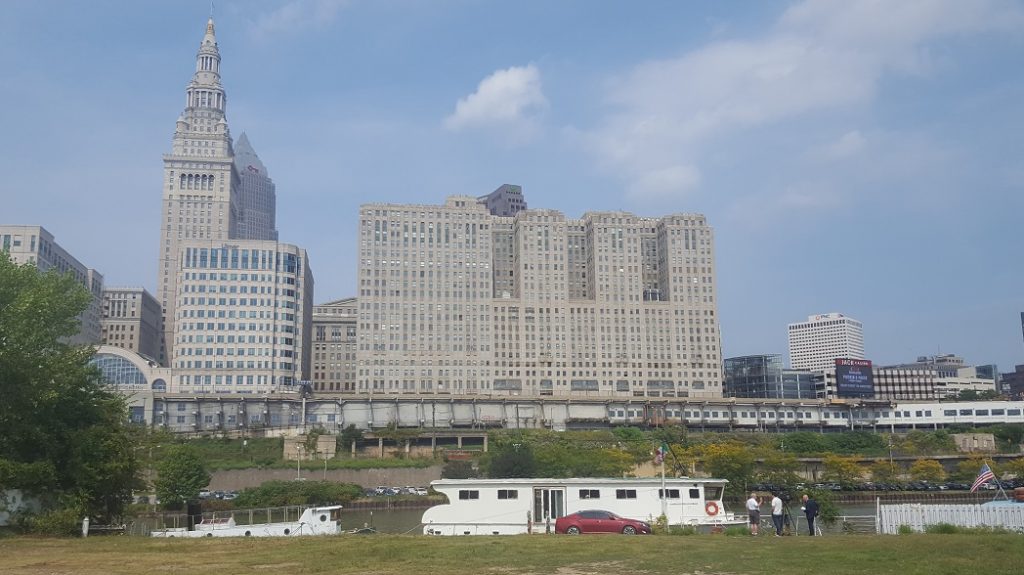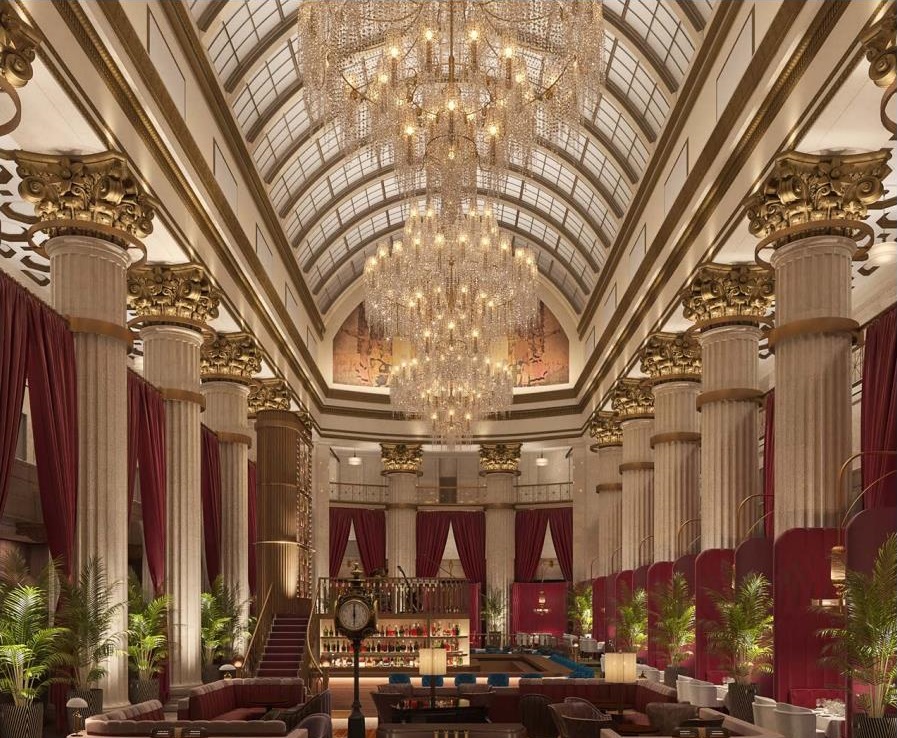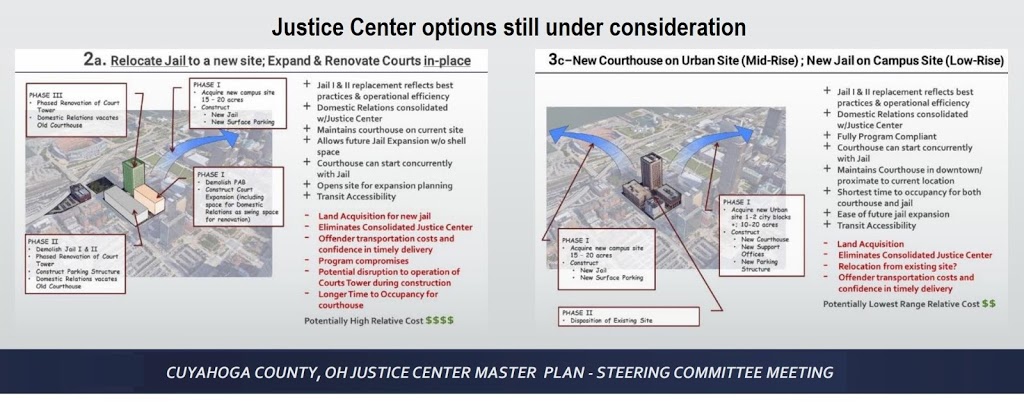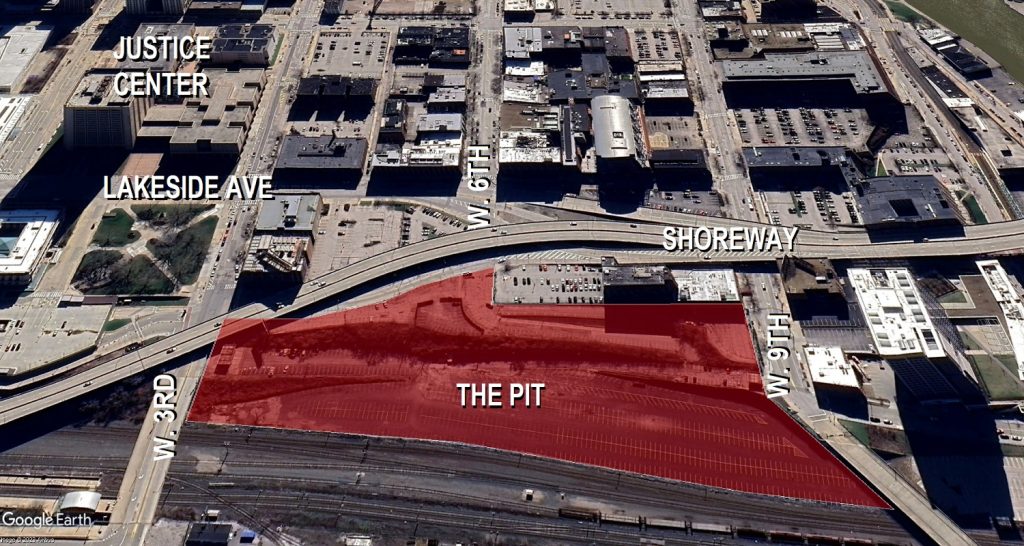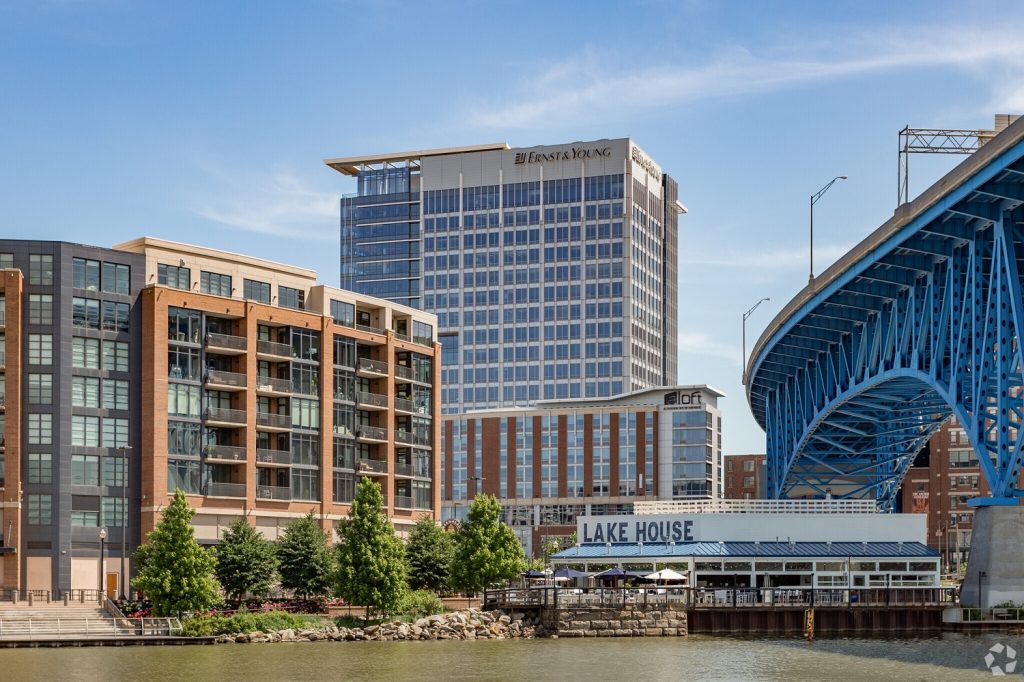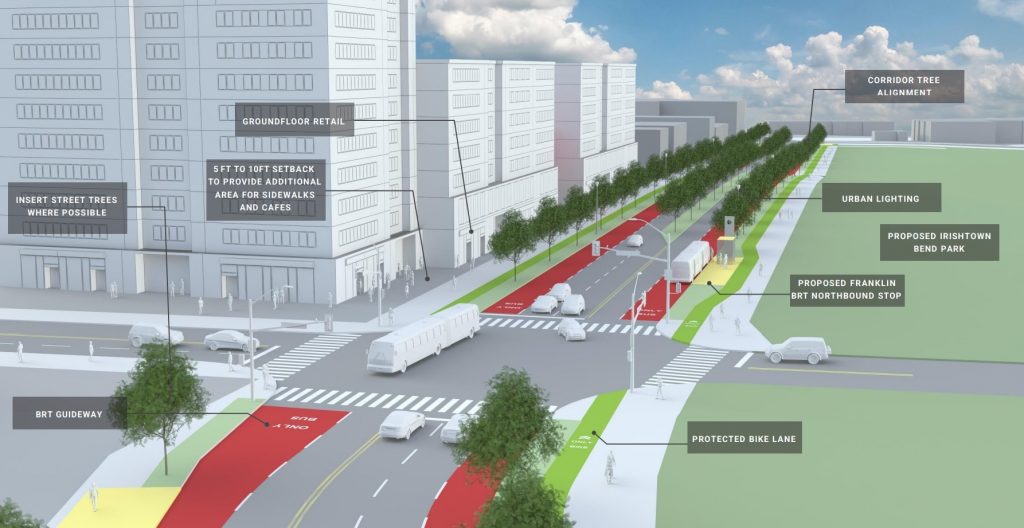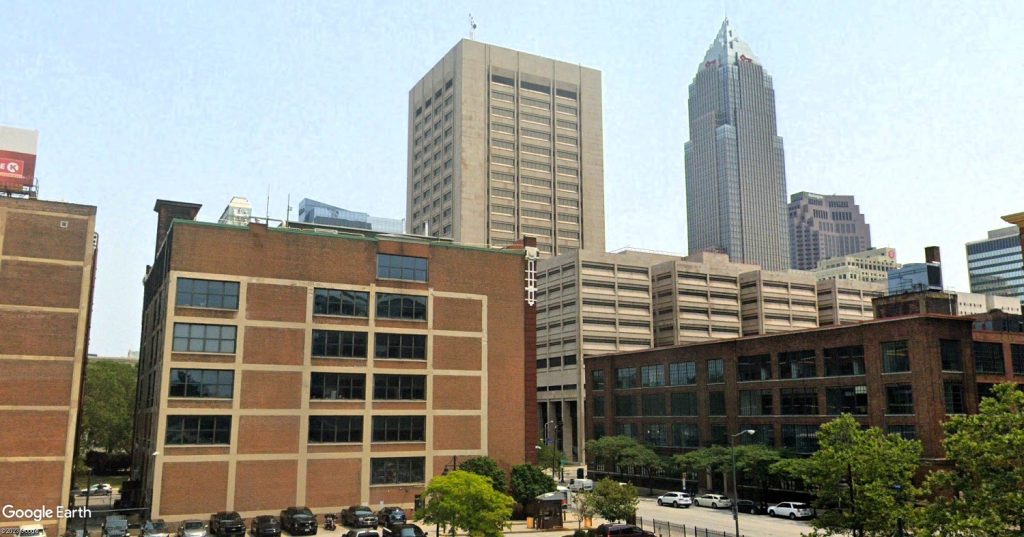
The Justice Center’s courthouse tower is in the center of this view. But one of the options for replacing the tower is to build a new courthouse where approximately this view was taken — from just north of the intersection of Lakeside Avenue and West 6th Street. This view is from the elevated Shoreway highway which may not be here much longer. In front of the current courthouse tower and slightly to the left is a Cuyahoga County office building called Courthouse Square that is also in play (Google). CLICK IMAGES TO ENLARGE THEM.
Downtown’s next ‘whale’ could net even more
A COMMENTARY
In local real estate parlance, a “whale” is a development project whose total floorspace measures 1 million square feet or more. Not only are they big, they’re tough to get. But there are two Cleveland entities who were able to do what Capt. Ahab could not — catch the whale. Two whales are under construction right now — Sherwin-Williams’ new headquarters tower downtown and Cleveland Clinic’s new Neurological Institute in the Fairfax neighborhood, near University Circle. A third whale is in the early stages of the chase, a stage where things are most fluid and thus, very intriguing.
The whale is the Cuyahoga County’s Consolidated Courthouse — a facility that would unite court facilities and related offices that are spread among multiple buildings downtown. It will be a massive project costing $400 million to $700 million to build or renovate. NEOtrans spoke with real estate insiders — developers, architects, engineers, construction managers, brokers, lawyers, financiers and county officials — to get their insights into this whale of a challenge that was posed by the county in two requests for proposals (RFP) issued last summer and whose deadlines passed last week, netting seven responses.
First, let’s understand that this county initiative really has two basic parts. One is to provide a consolidated courthouse for the future. That could be accomplished by building a new structure somewhere else downtown, away from the current 7-acre Justice Center campus whose jail facilities and police headquarters are departing, respectively, for Garfield Heights and downtown’s ArtCraft Building. Or it could involve renovating another, existing building somewhere else downtown. Or it could involve renovating the existing courthouse tower either as part of an expanded courthouse complex or with new uses.
That might leave standing alone on the Justice Center campus the 1977-built, 420-foot-tall, 26-story courthouse tower at 1300 Ontario St. In the tower are many court offices and hearing rooms that are jammed into every conceivable space — hallways, closets and shared rooms that cause scheduling conflicts and security issues. It’s why county officials want to replace or augment the 675,887-square-foot tower (not including its 124,230-square-foot atrium or 318,738-square-foot underground parking garage with 645 spaces) with a consolidated courthouse having 893,120 square feet of space. Again, that doesn’t include atriums or parking decks. Those will certainly be provided and push the project well into the whale category.
The second part of the county’s initiative is to sell, lease or otherwise put into play the courthouse tower, its surrounding pair of jail blocks, old police headquarters, and the land on which they set. This also includes offering the nearby, historic, county-owned Courthouse Square building, 310 W. Lakeside Ave. But just because county officials want to see what responses they get for both the Justice Center property and for the future courthouse, doesn’t mean they are separate issues.
A proposal could involve an investor partnership acquiring the Justice Center site, renovating the poorly built courthouse tower and leasing it back to the county as a courthouse again while developing the rest of the site, plus Courthouse Square, with expanded courthouse offices and other uses like a hotel and/or residential uses. Or the county could pick two proposals — one that builds a new consolidated courthouse away from the Justice Center campus and the other that repurposes the Justice Center campus with new uses.
As noted earlier, there were seven responses to the Courthouse/Justice Center RFP. And the responses appear as varied as the county hoped they would be, giving them and their consultant, CBRE Group Inc., a wide variety of choices to compare using its scoring matrix. NEOtrans was unable to secure a copy of the matrix as the county and CBRE cited non-disclosure agreements. There is no timeline for making a decision, a county spokesperson added.
However, several years ago when the county began looking for new sites for its jail and courthouse facilities, a steering committee measured those sites with criteria that anyone might expect in this case. The committee wanted a new courthouse downtown, built as close to the existing one as possible because supportive services are already nearby. That includes many law firms, parking areas, public transportation and restaurants for courthouse employees, jurors and visitors. Obviously cost-effectiveness is a key issue. Major, long-term assets and their cost of capital are measured over a 30-year timeline. Which project costs the least in that term is going to rate highly. And a courthouse plan that could be delivered with confidence more quickly and with fewer disruptions to courthouse operations would have won more points, too.
Plus, at least several acres of clean land that involved as few owners as possible was desired by the steering committee. It should be noted that the committee had preferred a cheaper mid-rise building over a more expensive high-rise building, thus requiring more land. And the committee preferred to move the courthouse facilities only once. The poor condition of the existing courthouse tower required that it would have to be completely vacated in order to be properly gutted and renovated. Thus, the courthouse offices and staff would have to be moved twice if the current courthouse was renovated to remain as a courthouse. That’s why the committee didn’t support remaining at the courthouse for the future. But the current RFP included the courthouse anyway to see what ideas the private sector had for it and what those costs might involve.
Two of the RFP responses — by Lincoln Property Company Commercial LLC (dba Lincoln Property Company) of Chicago and by U.S. Realty Advisors of New York City — may involve acquiring the Justice Center campus and leasing some or all of it back to a large, single tenant. Those types of deals are often pursued by these two firms, according to sources who spoke on the condition of anonymity. The question is — if it is a large tenant, who is it? Is it Cuyahoga County? Unfortunately, these are the only two proposals into which NEOtrans has few insights. All parties are under non-disclosure agreements.
One of the two optional, existing-structure sites proposed for the new courthouse is already a whale — the 1.4-million-square-foot Union Trust Building, 925 Euclid Ave., known more recently as the Huntington Building and the Centennial as it will turn 100 years old next year. Millennia Companies has put on hold converting the former office building into apartments, a hotel, a museum, retail and restaurants. The other existing-structure site is the 900,000-square-foot Landmark Building, 101 W. Prospect Ave., owned by Bedrock Real Estate. It’s currently Sherwin-Williams’ headquarters until it moves into its new tower, scheduled at the end of next year. A portion of the 93-year-old building was never built along Ontario. If designed and constructed as was planned in the 1920s, it could add another 230,000 square feet to the Landmark.
Two sources indicated that repurposing these buildings for courthouse facilities might be difficult. While they lauded their large, opulent, Gilded Age bank lobbies as having a courthouse-like appearance, beyond them the spaces are constrained. They cited their low ceilings and many structural support columns as complicating the construction of court rooms and open-office spaces, possibly increasing costs above what might be needed for new construction. But if they don’t make the cut, all is not lost for them. The Biden Administration recently announced new guidance for federal incentives to aid in the conversion of office buildings into residential. And given the locations of the Centennial and Landmark on rail and bus rapid transit lines, they would likely qualify for the incentives.
Two proposals offer to make use of the Justice Center campus. At least one of them, by DMD Development Group of North Olmsted led by DiBenedetto Real Estate Group, includes keeping the courthouse facilities on-site but in new buildings, designed to look like classic-but-demolished buildings from downtown Cleveland’s past, arrayed around a public green space. After the new buildings are built and the courthouse functions are relocated to them, DMD proposes demolishing the existing courthouse tower and replacing it with a replica of the 19th-century Hollenden Hotel on Superior Avenue that was razed in the 1960s.
That might meet one of the county’s apparent desires — to expand the convention center further and construct another large new convention flagship hotel. The Justice Center campus is reportedly being eyed for this expansion. Convention officials said the current $49 million expansion that’s underway across Ontario, converting the 120,000-square-foot Global Center for Health Innovations into meeting and exhibit spaces, is enough to put the city in the middle of the pack of competing for national conventions. But both Cincinnati and Columbus offer larger convention facilities and attract larger events.
Reportedly, DBL Development’s proposal seeks to capitalize on that demand by including expanded meeting and hospitality uses, plus residential and retail. There are rumors that the county wants a new convention hotel as large as 1,000 rooms but no one is commenting on the record. It isn’t clear if DBL intends to retain the courthouse tower and, if so, for what purpose. DBL representatives have not made their proposal public, citing a non-disclosure agreement.
DBL includes Rico Pietro, a principal at real estate brokerage Cushman and Wakefield, according to an attendance sheet NEOtrans secured for a Courthouse Consolidation RFP briefing meeting held Aug. 7 at the Justice Center. But sources said DBL also includes Ari Maron of Cleveland-based MRN Ltd. and Erik Loomis, president of Cleveland-based construction firm Loomis Companies.
It is apparent that the only proposal that offers constructing a new courthouse at a site not on the existing Justice Center campus was submitted by Twenty-One Six Development, led by Beachwood-based TurnDev. That firm is redeveloping the ArtCraft Building for the police headquarters. Their courthouse site involves properties between West 3rd and West 9th streets, north of the Shoreway and south of the railroad tracks, including a parking lot derisively known as “The Pit.” Those properties are owned by the Kassouf and Coyne families. In an e-mail to NEOtrans, Jon Pinney, managing partners of TurnDev and law firm Korman Jackson & Krantz, confirmed the rumors but couldn’t say much more.
The site is less than one block away from the current Justice Center campus. The site is also large, measuring about 8.5 acres, allowing a lower-cost, mid-rise courthouse complex to be built above a podium of parking that could effectively extend the lake bluff north toward the railroad tracks. The bluff is about 50 feet higher than the existing parking lot down in the pit, meaning four or five levels of parking decks could be built here, offering thousands of spaces of parking. The top of the parking decks, level with the bluff, could offer greenspaces, extend West 6th Street northward and be a platform for one or more courthouse buildings.
What’s also intriguing about this site is that, if the Shoreway is downgraded to a boulevard west of West 6th as is proposed in the city’s lakefront planning, the pedestrian linkages with downtown will be improved. The site is within walking distance to existing law offices, restaurants and to public transportation. And if Twenty-One Six Development acquires the Courthouse Square building, more close-by law offices could be located there. However, this building has often been suggested as a possible residential conversion.
One thing is certain, if the county moves forward with this effort involving as many partners and funding sources as possible in a public-private partnership, the county’s consolidated courthouse effort could remake and enliven a large part of downtown. It’s a part of downtown that has, at best, gotten tired-looking and at worst, become a place merely to park in or pass through. It’s clear that the county wants to reset the Justice Center campus to catch its whale. It could soon hook that leviathan and more.
END

